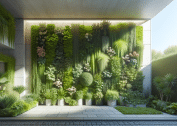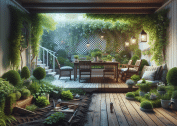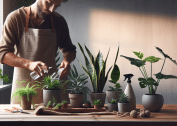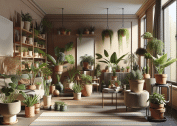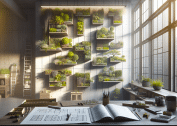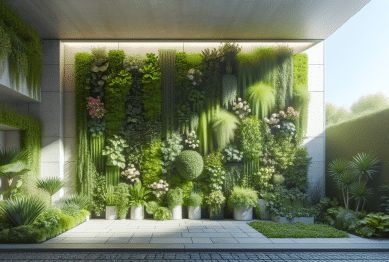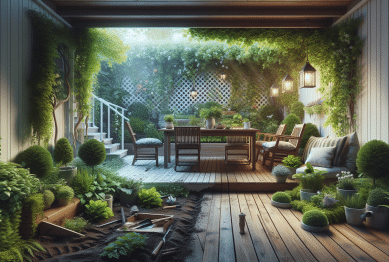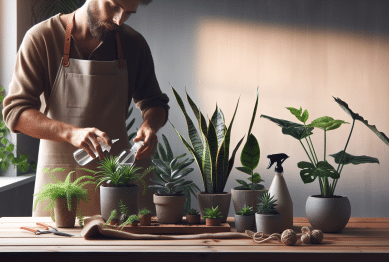Discover how the choice of indoor plants transforms a home’s energy, air quality, and design character. This engaging guide explores the benefits of houseplants, easy-care varieties, placement tips, and the science behind why greenery can elevate any living space.
Bringing Nature In: The Rising Appeal of Indoor Plants
Indoor plants have moved from afterthought to a true statement piece in modern home design. Whether large leafy palms or compact succulents, greenery makes a room feel alive. The current demand for biophilic homes—those fostering a connection to nature—continues to grow. Studies note that just adding a few well-placed houseplants alters the atmosphere and improves wellbeing (Source: https://www.ncbi.nlm.nih.gov/pmc/articles/PMC4419447/). Homeowners enjoy bringing nature indoors, and this simple act can reshape a space’s entire look and mood.
Many people choose indoor plants for their aesthetics, but there’s more beneath the surface. Plants do more than look good. They filter airborne toxins, contribute moisture, and offer a sense of calm that’s hard to replicate with artificial décor. Urban dwellers especially benefit—they gain access to a slice of the great outdoors in confined apartments. Some designers even believe that a home without greenery feels incomplete.
Interest in sustainable living also pushes the popularity of houseplants upward. Growing indoor plants is a hobby accessible to nearly anyone, regardless of gardening experience. Recent data suggests households with greenery may report higher satisfaction with their living environments (Source: https://www.epa.gov/indoor-air-quality-iaq/air-quality-home). The result? The humble potted plant emerges as both a natural air filter and a centerpiece of stylish living.
Health Benefits Beyond Aesthetics: More Than Just Decor
The perks of integrating indoor plants stretch well beyond beautifying rooms. Houseplants play a practical role in enhancing air quality. Many varieties—like spider plants, snake plants, and peace lilies—are known for absorbing and neutralizing harmful VOCs (volatile organic compounds) released by furniture and cleaning products (Source: https://www.epa.gov/indoor-air-quality-iaq/air-quality-home). In essence, they work silently, filtering the air every day.
Improving air quality isn’t the only advantage. Indoor gardening also helps people lower stress levels. Tending to houseplants or just having them nearby may help reduce anxiety and promote overall wellness. Research from horticultural therapy has found that growing and tending to plants can produce calming effects, lower blood pressure, and even improve focus for work or study (Source: https://www.tandfonline.com/doi/abs/10.1080/14616696.2017.1313655).
Cognitive benefits linked to houseplants are gaining attention. Some workplaces purposely add greenery to help staff concentrate and reduce distractions. The same can be achieved at home, especially for those working remotely. A pot of moss or pothos beside a desk can boost productivity and spark creativity. Children also reap rewards, learning responsibility and enjoying the natural curiosity fostered by growing things indoors.
Choosing the Right Houseplant: A Guide for All Spaces
Diversifying your interiors with houseplants is all about selecting types that fit your home’s light, space, and routine. For bright, sunny rooms, consider succulents or cacti. For lower-light corners, ferns and snake plants thrive. Popular options like pothos, monstera, and ZZ plants are beloved for their forgiving nature. No ‘green thumb’ required—many varieties bloom with minimal effort, making them ideal for beginners (Source: https://extension.psu.edu/best-houseplants-for-beginners).
Before picking a plant, assess your lifestyle. Are you at home often or travel frequently? Some species cope well with neglect, like sansevieria or philodendron. If you’re invested in daily care, flowering options such as African violets or orchids add bursts of color but may require more attention. Pets are a consideration too; certain species are toxic to cats and dogs, so research compatibility before bringing greenery into pet-friendly homes.
Consider available space. Tall palms or fiddle-leaf figs make dramatic statements in corners, while trailing vines or desktop succulents add accents to shelves and desks. Pick sizes and shapes that complement your furniture. Play with planters, from minimalist clay to colorful ceramics, to further personalize your indoor garden. Remember—well-chosen houseplants enhance any style, from rustic to modern chic.
Placement Strategies: How to Make Greenery Stand Out
Thoughtful placement of indoor plants does more than fill empty spaces; it can visually enhance a room’s layout. When clustering several pots together, vary plant heights and leaf shapes for depth. Corners often benefit from tall species, while small pots can accent coffee tables or windowsills. Try layering multiple containers for a lush, tropical look.
Lighting plays a crucial role. Observe where sunlight falls throughout the day, and match plant types accordingly. East-facing windows favor most houseplants, receiving gentle morning sun. South-facing exposures work well for light-loving succulents or citrus trees. Not sure how much light a spot gets? Many plant retailers offer guides, and some smartphone apps help analyze lighting right in your home.
Think vertically to maximize greenery, especially in small spaces. Hanging planters, wall-mounted pots, or shelves dedicated to trailing species can transform bare walls into living art. Strategic placement isn’t just about looks—it ensures each plant thrives in the right microclimate. Rotate containers occasionally so all sides get light, and experiment until you find combinations that suit both your eye and your home’s unique qualities.
Care Basics: Tips for Long-Lasting Houseplants
Ensuring indoor plants flourish starts with understanding basic care requirements. Most houseplants favor indirect sunlight, soil that drains well, and routines that avoid extremes. Overwatering can be more dangerous than neglect, so only water when topsoil feels dry. Drainage holes in planters are essential to prevent root rot (Source: https://hort.extension.wisc.edu/articles/indoor-plant-care/).
Humidity matters too, especially in winter. Leaves might brown on the edges when the air is too dry. Misting plants, grouping them together, or setting pots on trays with pebbles and water can boost local humidity. Fertilize sparingly—most indoor species only need added nutrients during the growing season, and too much can harm roots. Occasional pruning helps plants stay tidy and healthy.
Pests like spider mites or fungus gnats sometimes find potted plants attractive. Regularly inspect leaves for signs of trouble. If issues arise, gentle remedies—such as wiping leaves with soapy water—can control them. Proper plant care is an evolving process, and a little observation goes a long way. Don’t be discouraged by occasional setbacks; learning as you go is part of the joy of indoor gardening.
Trends and Creative Touches: Styling with Plants
Design trends show houseplants used not just as accessories, but as integral parts of a home’s style. Many people enjoy creating mini indoor jungles or dedicating rooms to greenery. Terrariums—small, contained plant worlds—offer a low-maintenance way to enjoy mini ecosystems on a kitchen counter or office desk. String-of-pearls and moss frames turn wall space into talking points.
Mixing textures and shapes creates a layered effect. Combine upright, leafy varieties with trailing vines for visual contrast. A few large, sculptural plants—like monstera or rubber trees—draw the eye, while clusters of small pots bring charm to bookshelves. Creative vessel choices, such as woven baskets, glass jars, or vintage bowls, expand decorating options beyond standard planters.
Colorful planters, plant stands, and DIY macramé hangers let personalities shine. You can rotate species with the seasons—refreshing a living room for spring or cozying up spaces for autumn. Even kitchens and bathrooms benefit from green touches, using herbs like basil or mint. As trends evolve, houseplants remain a flexible, ever-refreshing way to inject life and creativity into any space.
References
1. Bringslimark, T., Hartig, T., & Patil, G. G. (2009). The psychological benefits of indoor plants: A critical review of the experimental literature. Retrieved from https://www.ncbi.nlm.nih.gov/pmc/articles/PMC4419447/
2. United States Environmental Protection Agency. (n.d.). Air Quality in Your Home. Retrieved from https://www.epa.gov/indoor-air-quality-iaq/air-quality-home
3. Gray, T., Birrell, C., & Kellas, J. (2017). Wellness and gardening: The green connection. Journal of Urban Design, 22(4), 443-455. Retrieved from https://www.tandfonline.com/doi/abs/10.1080/14616696.2017.1313655
4. Penn State Extension. (n.d.). Best Houseplants for Beginners. Retrieved from https://extension.psu.edu/best-houseplants-for-beginners
5. University of Wisconsin-Madison, Horticulture Extension. (n.d.). Caring for Indoor Plants. Retrieved from https://hort.extension.wisc.edu/articles/indoor-plant-care/
6. American Society for Horticultural Science. (2020). The influence of plants on indoor environments. Retrieved from https://ashs.org/


